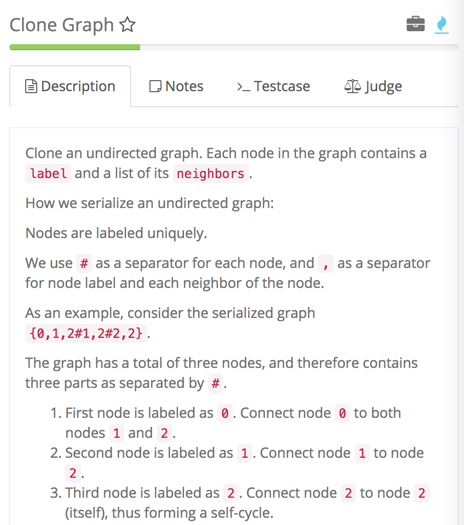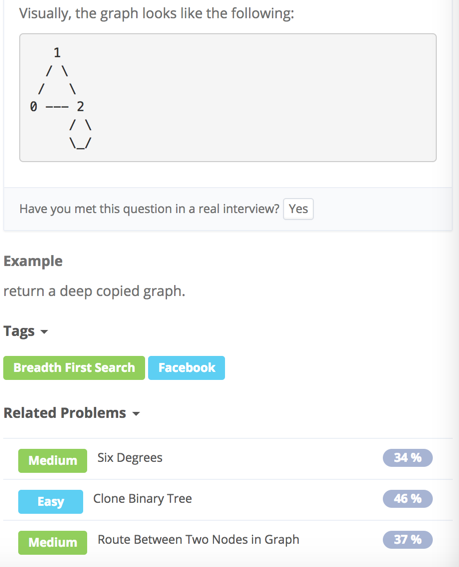@w1024020103
2017-07-07T11:55:36.000000Z
字数 1431
阅读 597
Clone Graph
LintCode LeetCode


这道题让克隆一个无向图,题目里关于如何序列化一个无向图的介绍对解题没有什么帮助。这道题仍然用BFS来解决,这个视频帮到我很多。
基本思路是,1、先克隆所有的点;2、再克隆所有的联结关系。
用一个HashMap来形成原图和克隆图的mapping,同时可以用来保存已经被visited的节点。HashMap的key是original node, value 是clone node. 同时,每逢bfs几乎必用的Queue用来辅助遍历。注意,每次要将某些节点offer进queue等待下一步遍历的时候,也要将这些节点加入到HashMap里表示已经visited.但是,注意一开始加入到HashMap里的时候,value先设为null,直到poll这个节点出来遍历该点的时候,再将mapping更新为key = original node; value = clone node. (为什么先设为null呢?)
当所有的点都被克隆完后,还需要克隆初原来图中的连结关系。我们需要遍历出original graph的每个点的每个neighbor, 然后在clone graph里边先get到对应的点,再在这个点的neighbors里边add所有的neighbor.
public class Solution {/*** @param node: A undirected graph node* @return: A undirected graph node*/public UndirectedGraphNode cloneGraph(UndirectedGraphNode node){if (node == null) {return null;}Queue<UndirectedGraphNode> queue = new LinkedList<UndirectedGraphNode>();HashMap<UndirectedGraphNode,UndirectedGraphNode> visited = new HashMap<UndirectedGraphNode,UndirectedGraphNode>();queue.offer(node);visited.add(node, null);while (!queue.isEmpty()){UndirectedGraphNode temp = queue.poll();UndirectedGraphNode copy = new UndirectedGraphNode(temp.label);visited.put(temp, copy);for (UndirectedGraphNode neighbor : temp.neighbors){if (!visited.containsKey(neighbor)){queue.offer(neighbor);visited.put(neighbor, null);}}}for (UndirectedGraphNode original : visited.keySet()){UndirectedGraphNode cpy = visited.get(original);for (UndirectedGraphNode neighbor: original.neighbors){cpy.neighbors.add(visited.get(neighbor));}}return visited.get(node);}}
